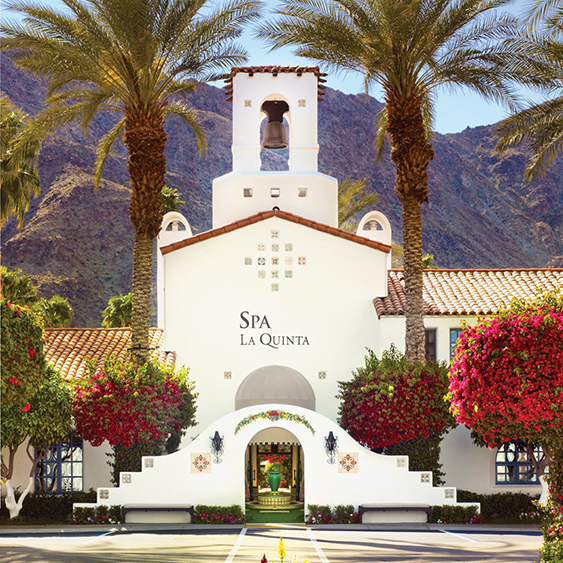
It’s early in the desert. Still, I get up for the light. As it turns out, I receive illumination in more ways than one.
In the Coachella Valley, at La Quinta Resort & Club, where Tinseltown’s legends from Bette Davis to Greta Garbo roamed before me, I ramble across a lawn adorned with orange trees, palms, cacti, burr-haircut grass, and ornamental statues—even a fountain or two. The sun has just begun to dapple the ground. There’s dew beading up on everything. And, the Santa Rosa Mountains, with a presence like profound guardians, radiate a hue as purple and promising as a farmers market’s fattest aubergine. Pensive, they loom against the grey plate of the implacable morning sky.
I’m headed to yoga, not fully awake. The walk from my casita, one of more than 700 suites that pepper the vast grounds, set in a place anchored, as well, by 41 varied pools, takes longer than expected. I get lost—and distracted. There are flowers, butterflies, and bits of glittery light to take me off task. Then there’s La Quinta’s history, which engulfs me as I walk by Frank Capra’s regular bungalow, the spot where he purportedly wrote It Happened One Night, the very cottage that became his good luck hideaway. Rent it, and you’ll sleep beside his actual typewriter. On the walk, I also pass Greta Garbo’s abode, now used for weddings, where yesterday a staff person allowed me entrance. I’m still awed by the vision of Garbo’s silk slip hanging in the closet, the photos, antiques, and other possessions that continue to suggest the magic of her life. The property, one of the United States’ first resort spa destinations, was built in 1926 by Walter H. Morgan. He envisioned it as a salutary retreat, a place where silver screen stars could escape the rigors of Hollywood and recoup from filming. Just two hours from Los Angeles, it proved popular with busy movie stars who were not allowed to venture too far away while in production. “I’m off to La Quinta,” famously crooned Bette Davis to a crowd of bedeviling paparazzi, more than once.
The property, one of the United States’ first resort spa destinations, was built in 1926 by Walter H. Morgan. He envisioned it as a salutary retreat, a place where silver screen stars could escape the rigors of Hollywood and recoup from filming.
When at last I reach the grand resort’s expansive fitness enclave, edged by tennis courts and a tranquil spa, enlivened by lawns, bikes in racks, and home to a huge, state-of-the-art gym, I rush to find Studio One. It takes me a moment to locate it, I expect a normal workout room. When I cross the threshold, however, I awaken instantly. That’s because this is no ordinary exercise space. Rather, it possesses monumental artwork, the sort which ignites the room. Two walls gleam and glimmer, alive with Buddhas—perhaps a hundred of them. The room feels as sacred as a church. Painted by California-based artist and yoga teacher, Amanda Giacomini, the embellished walls comprise a portion of Giacomini’s artistic crusade to paint 10,000 Buddhas, many of them gilded, in public places.
The artistic mission, called 10,000 Buddhas, still in progress, was inspired by a pilgrimage to India, where Giacomini embraced the idea to send love and light via this work—a kind of installation piece with simultaneous moving parts. Currently on display from Miami to California, her various creations range from large scale murals to tiny 22-karat gold portrait-style works; they include screen prints on paper and replicas of vintage wooden Tibetan prayer wheels, as well. In Studio One, the Buddha walls welcome and warm my practice. As background, they enhance the wisdom offered by my teacher. They set a mood that finds the harmonic yes spot between calmness and focus. The Buddhas absolutely take me deeper, lighting a flame that had felt blown out.
Later in the day, I stow away in La Quinta’s labyrinthine Spa La Quinta, an elegant enclave that lets the resort’s original Mission Revival architecture and bygone mood of romance set a scene that envelops me in palpable Hollywood glam. Classic, yet wholly contemporary, it has more than 40 treatment rooms, most with panoramic windows that celebrate the landscape and property. Despite its size, as in all aspects of La Quinta at large, the spa feels intimate and personal—as if I have it all to myself. With a bevy of treatments on the menu—including location appropriate choices, such as Glistening Agave Body Glaze, which speaks to the desert’s drying effects, the spa’s scope reaches to Ayurveda and laser work.
Having been hiking amid desert sand and driving for days with dogs in the car, I realize I need a deep cleansing and moisturizing facial to set things right. They offer some special face treatments with Babor, a brand I love. But, in the end, I settle for a 50-minute Hydrafacial MD, which my therapist customizes with Babor—so I get the benefits of both. And note to dog lovers: the spa joins housekeeping in spoiling your canines. While staff provide puppies with beds, bowls, door hangers, placemats, and toys, the spa offers in-room massages for pooches, ensuring your entire traveling troupe collapses into stress-free bliss while on property.
There’s much to do at La Quinta Resort & Club. Though the spa and fitness area offer a plenitude of classes, spa treatments, and seminars, though the resort boasts a top golf course, hiking trails, and fine restaurants, the resort manages to achieve its founder’s vision—it provides a portal to a different pace. Time seems to stand still here. The result is sheer renewal.
Becca Hensley
Becca Hensley is Editor at Large for Insider's Guide to Spas. Based in Austin, she writes regularly about travel and spas. She believes a good story draws you in like laughter in a crowded room, and challenges you to do it justice. Her work appears regularly in Austin Monthly, Travel Channel, Toronto Star and National Geographic Traveler.